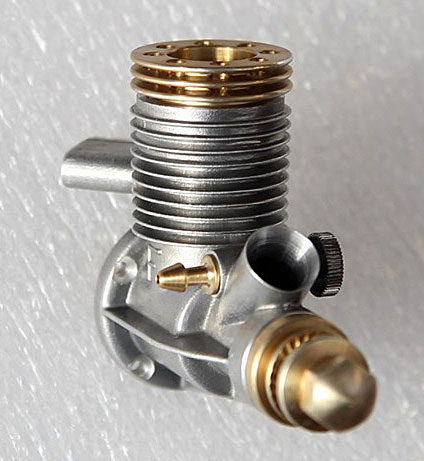A View from Broadway
The Fora 8cc LE. Aerohobby.ca photo.
A Foray into 1/2-A Proto Speed, Part 2
By Ken Burdick
September 2020
See Part 1
Yes Folks, it’s true.
The Foras arrived in the mail a few days after Yaro shipped. It looks every bit as nice as the ones in the pictures, and I was eager to measure the little dynamo, but try as I might, I could not get the head off!
For most, this shouldn’t be a problem, but hey, I want to measure the thing. I tried heat, holding it in a rag but the little Ukrainian wouldn’t budge. Finally, I built a ¼” 5 ply mount and bolted the little mule to it. I then put it into a vise and heated it with a torch to about 300 degrees F. I put the head tool into the holes and added an extension to it and that did the trick. There was a nice coating of anti-seize compound on the threads which made it all the more a mystery; possibly it’s the coating.
As with donuts, timing is everything
 I measured the engine and put the numbers into Luke Roy’s timing calculator.
I measured the engine and put the numbers into Luke Roy’s timing calculator.
The results are below. I measured the head clearance at .0164 with two shims under it. With 1/2-A performance heads especially, it’s a trial and error process and once you get a formula, stay with it. The chamber is a “hat” shape, like a derby, and has been used since the 1960s in many engines. I think the shape and volume should work well.
Inside the engine, I could see some changes in design from the older GRS version that was sold by Richard Stubblefield and the late George Cleveland.
First is the crankshaft, and while I did not measure it’s o.d., the port in it is smaller-looking that the older GRS. What is interesting is the GRS engine used a tapered crank port that belled out from .203 dia to .289 at the exit. The new version looks to be about the same inside diameter of .197 but has the teardrop cut into the counterweight; it does not bell out. This feature was first used in R/C cars and slowly gained acceptance in high performance aero engines.
There seem to be no timing changes from the old to the new engine, at least as I measured it, so I expect to see similar performance as I have in the past.

Our next step is to run the LE and see what numbers we come up with. I know from experience that a 4x3-1/2 prop will produce over 100 mph in Proto Speed standing start time with a ground RPM of 34,000. The real trick here is to get the engine to unload in the air to say 35,000 and now were talking go-fast. I was hoping to have a Cyclon of known quality to compare our LE to, but it has not arrived, so we’ll use 34,000 rpm on a Combat prop as a baseline to good performance.
Not surprisingly, the new Fora ran 32,000 rpm after three tanks of break-in fuel. The plug didn’t blow and it needled well. This is in the wheelhouse of what I expected, so we have a starting point.
I will disassemble the little RPM miser and try to determine where the missing 2,000 RPM are hiding. On the same fuel and same day, my Picco ran 34,000 RPM so it’s gotta be there someplace.
The spreadsheet below is a combined effort of my RPM numbers and those of Lane Puckett. Lane has done some extensive comparisons that should shed some light on the Fora to Cyclon engines. I suspect the Cyclons he ran may have needed some piston and liner work because they seem to be a bit low on RPM. Also Lane recorded the 1cc engines, we are looking at the .8cc.
We have a winner!
 Geezers, I'm not sure how to say what I discovered, but I'll try.
Geezers, I'm not sure how to say what I discovered, but I'll try.
I always put the Fora into the “me too” category and my previous engines seemed happy at 33,500 rpm on 35% vitamin N.
I just left it at that. Not a bad engine for Combat and it would keep up with the best of them. But this dive into the new Fora has changed my outlook entirely.
Yesterday I ran three 2-ounce tanks of fuel as per ABC break-in. I then tached the thing at 32,000. Typical for a tight engine with a lot of head clearance. I lapped it a bit to get the tight spot into the last 3/16” or so of the stroke. I already knew the bottom end was perfect from Yaro’s bearing and set up.
I ran the engine again today and was blown away. 34,500 on a green Combat prop. Altitude was 900 feet, barometer was 101 KP, temp was 80 deg F. The same 10% high-oil fuel and a new Nelson plug.
Never have I witnessed such a remarkable change. I have one more Fora that is also tight but that one will likely get sold or kept for parts.
The conclusion I have come to is this. Buy a Fora LE from Yaro. If it’s too tight get someone who can lap the liner to the right fit — this engine can PLAY!
Some very interesting observations and work are included in the links below. Contributors include Doug Galbreath, and Chris Murphy. Some of the clearance figures have decimal errors but it should be obvious.
RPM figures from Lane Puckett and Kennyb — click for chart
Martin Gregorie engine article
TGC Timing Calculator
|
|
||||||||||||||||||||||
![]()
|
|
Deck Height |
0.0500 |
Stroke / 2 |
0.1900 |
Rod/Stroke Ratio |
2.0605 |
Engine Displacement |
0.0473 |
Swept Volume from Exhaust Closing |
0.0348 |
Exhaust Port Values |
|
Distance ATC |
0.2800 |
Distance BBC (Port HGT) |
0.1000 |
Port Duration (DEG) |
136.89 |
Piston ATC (DEG) |
111.55 |
Piston BBC (DEG) |
68.45 |
Inlet (Crank Port or Rotor) Values |
|
Port Opens ABC (DEG Crank Port or Rotor) |
30.25 |
Port Opens BTC (DEG Crank Port or Rotor) |
149.75 |
Port Close ATC (DEG Crank Port or Rotor) |
34.12 |
Total Intake Timing (DEG Crank Port or Rotor) |
183.87 |
|
|
Well there you have it, lil' geezers — this project produced a real winner, and I had no idea of that when I began this, it’s so nice to be surprised like this. Wanna fly 1/2A Proto? The formula is well laid out for you. I suspect that with a little more effort on my part, 35,000 ++ RPM is not out of the question.
-- Kennyb
Back to Bod Busters main page
Back to Speed main page
Flying Lines home page
This page was upated Sept. 8, 2020


